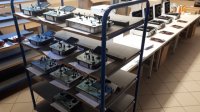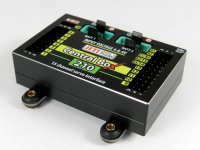For the overview, here is the list of so far available telemetric sensors of JETI Duplex system with their basic characterization.
| sensor |
main use |
other scanned and transmitted data |
|
MSpeed |
measures the speed of models by means of the Pitot tube |
temeprature measurement |
|
MU3 |
independent monitoring of three volatges |
|
|
MVario |
vario - ascending and descending of a model |
relative altitude, atmospheric pressure, and temeprature measurement |
|
MULI6s |
monitoring of the current state of up to 6 Lixx cell |
|
|
MRPM, MRPM-AC |
speed of the engine or of other rotating parts, propeller power |
|
|
MT125, MT300 |
double electronic thermometers for for the range up to 125 and 300 oC |
|
|
MGPS |
measures the position of the plane, its distance, direction, and speed by means of GPS satellites; enters the data into the self memory |
date and accurate time, altitude, GPS coordinates, course, and azimuth |
|
MUI 30, 50, 75, 150 a 200 |
measures current, voltage, and capacity of batteries with current range from 30 to 200 A |
engine run time |
As it can be seen from the chart, now it is possible to get probably all the meaningful data about the flying model by means of produced telemtric sensors. Probably except for very sensitive flow meters, I cannot think of any other data that modellers could possibly be interested in.
All the sensors have a possibility of relatively wide range of user setting of displayed data, limit data, and warning acoustic signals. The transmition of measured data from a model to a pilot is fully possible by means of JETI Duplex system.
The fact that for each type of measured data individual sensor is produced is their big common advantage. Thus you can install only those sensors whose data you are interested in to every model.
Measuring the speed of models is not as common as it should be, regarding its importance. After all, in every "adult" plane, the speedometer is probably the most important appliance on the dashboard. Various substitute methods such as measuring the speed by means of GPS satellites or terrestrial devices are accurate, but they show only the speed of the model in relation to the ground. But we need to measure the speed in relation to the surrounding air. This condition is fulfilled only by speedometer based on Pitot tube, which means a parallel to the speedometer of huge planes. And exactly this type of the speedometre has been developped and is produced by JETI model as a telemetric sensor of Duplex system.
Description
MSpeed sensor consits of two parts, brass Pitot tube and the base with necessary electronic circuits. (Pict. 1).
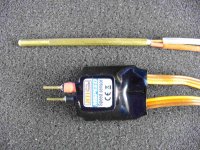 |
Both parts are linked by two silicon hoses with outside dimater of 2.4 mm. Connecting hoses 2x90 cm long are a component of the product. The length of these hoses does not influence the function of the device and thus we can shorten them arbitrarily. We do not safe much at the weight, as 1 meter of the hose weighs about 5g, but sometimes extra hose could disturb in the model. There are two 30cm long triple core cables protruding from the electronic board. As in other Duplex telemetric sensors, one is aimed to be connected to a transmitter or an expander, and the other, if connected to any servo outputs of the receiver, can remotely switch on or switch off acoustic signalisation or delete maximal or minimal measuerd data from the memory of the sensor.
Pitot tube
A part of the MSpeed sensor is a really miniature classic Pitot tube (Pict. 1) - diameter of 3mm, length 54 mm, weight 3g. The front hole with the diameter of 0.8mm measuers the dynamic pressure and is connected to the red hose. Eight side holes are of a 0.2mm diameters and measuer static pressure. At the end of the tube, two brass tubes with 1mm diameter are connected by means of soldering. These are for connecting two silicon hoses. Despite their small dimension and weight, the tube is solid enough and I believe there is no need to be afraid of damage, even in the case of an accident. I was worried that so tiny holes could be blocked by dirt. But I can confess that the two Pitot tubes, tested both in common working and in extreme testing, did have not needed any cleaning for several months, even after landing in high grass. When fitted to the plane, the tube should protrude at least 20mm.
Base
Double-layered PCB has the proportions 21x21x12 mm and weight of 10g. On one side of the board there is a differential pressure sensor, on the other side there is a processor and a few little electronic components. Plastic inputs of the pressure sensor are reduced to 1mm by means of brass tubes. Power supply of the electronics runs from the transmitter, I measured only 9 mA current consumption.
Module testing
Testing of JETI MSpeed module itslef was very complicated and time consuminig. It lasted almost half a year, not only because the testing had to be divided into a few groups due to technical possibilities and three different software versions have been tested one by one. But mainly because we had to wait for the right weather when processing the most important part of the testing - accuracy of speed measuring.
Testing the accuracy
MSpeed telemetric sensor is aimed to measure the speed, that is why this testing is the most importatnt. The producer states the measuring range from 20 to 350 kmph. Such a wide range was very difficult to check directly and by one method, thus the testing was divided in two parts. For measuring the speed from 20 to 120kmph, the sensors were installed on the long tube fitted to the roof of a car. The speed measured by the MSpeed sensor was then compared with the data get first from one, later from two satellite speedometers. We made a few hundreds of measurements this way.
For measuring higher speeds, it means up to 350 kmph, we unfortunatelly did not manage to get a suitable car, thus we measured the airflow speed by means of digital measurement tool (Pict. 2).
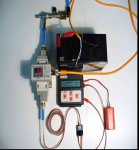 |
The testing ended up above expectation. The tested sensors were able to measure the speed from 28 to 390 kmph. Also the accuracy of the measurements was a pleasant surprise. In the range of speed from 40 to 380 kmph, the inaccuracy was from 3.5 to 4%.
As for the accuracy of displayed figures, it is probably good to pay attention to one attribute of the sensor that is not mentioned in the manual. The pressure sensor is fitted with the function of automatic reseting of the speed. It means that at every single switch-on of the MSpeed, the value of the speed is automatically set at 0 kmph. Thus if the wind is heavier, for example at slope-soaring, it is appropriate to swith on the model in the position where the Pitot tube is turned against the wind direction.
Thermic stability
During the testing, I was a few times informed about the problem of thermic instability of similar devices for speed measuring. The company of JETI model states operating temerature from 0 to +85 oC. Used pressure sensors have integrated temeprature correction for the range of temperatures from +10 to +60 oC and the producer added even their own temeprature correction for wider range from 0 to +60oC. I have tried to find the inaccuracy of speed measuring caused by the change of the temperature in the range of -5 to +75 oC. After numerous measurements and average inaccuracy of negligible 0.7 to 1.2% was found.
Installing the speedometer
The results under the testing conditions are certainly great. Ascertained accuracy of MSpeed is the same as in a better speedometer of our cars. Unfortunately this accuracy can be deterorated even up to complete inapplicability of measured data because of inappropriate installation of Pitot tube. To find an ideal place for fitting is a very complicated task even at huge planes, not to mention models. It is necessary to find such a place that the airflow is not influenced by the body of the model itself or by the airflow from the propeller or from the exhaust pipe. When installing at the wing leading edge, we must realize that in turns the speed data will be distorted, the larger the wingspan and the further the sensor is from the axis of the plane, the more distorted data. Such placing of the Pitot tube could cause problems e.g. at larger thermo gliders.
Another limitation when choosing the place for fitting is the fact that the Pitot tube should be as much protected from mechanical harm as possible, both at landing and when transported. Placing at the fuselage nose is definitely great from aerodynamical point of view, but the Pitot tube placed this way is very easy to break. In the manual of the model there are several pictures depicting recommended ways of insatallation. When testing, I placed it inside the wing at the Bird model (full composite airplane with folding propeller made by Radek Munzar) (left picture), and to the rudder at the Fox model (jet engine, exhaust pipe under the model) (right picture).
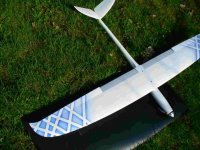 |
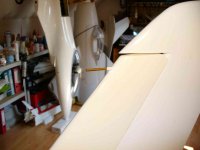 |
So the Pitot tube is installed, straight and parallel to the axis, but what if the plane flies, e.g. during landing, under different angle of attack? After all, at some models the angle of attack can be even 10° or 15°. Can the speedometer at such an angle detect proper actual speed? The test proved that if the Pitot tube is up to 20° out of axis against the airflow, the inaccuracy is about -1 kmph for each 5° of the difference. At 30° of the difference the speedometer shows -10 kmph and at larger angles the inaccuracy is larger again (measuerd at the speed of 40 kmph). According to me the sensor is safe to use up to the difference of +/- 20° from the axis of the airflow and that is definitely enough for our purposes.
All the telemetric sensors of the Duplex system have a possibility for adjusting minimal and maximal values, at which the acoustinc signal is set in the transmitter. Possibilities to adjust acoustic information signal are even larger at MSpeed sensor. As at other Duplex sensors, it is possible to adjust achievement of maximum and minimum speed. In addition in the group of options "speed monitor", the third optional speed is also possible to adjust. When approaching this value, we will be gradually, in advance, and in several steps acoustically warned.
Telemetry is definitely very useful and beneficial for modellers. But it is also necessary to consider what entries are important at certain model and which are on the contrary useless. Duplex module system makes it possible for the modeller to adjust what figures to observe, which are important, and which are useless. And to know how fast I fly, or if I approach to falling speed, is surely very useful information, especially for huge models.
At the end I would like to thank Mr. Radek Stratil for providing digital flow meter and patient help with measuring.
Ing. Miroslav Pastyřík






